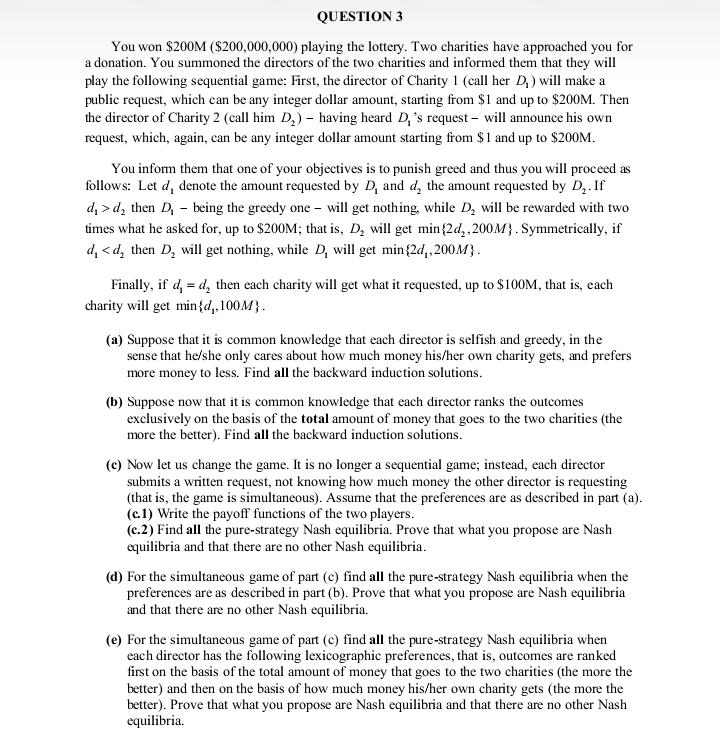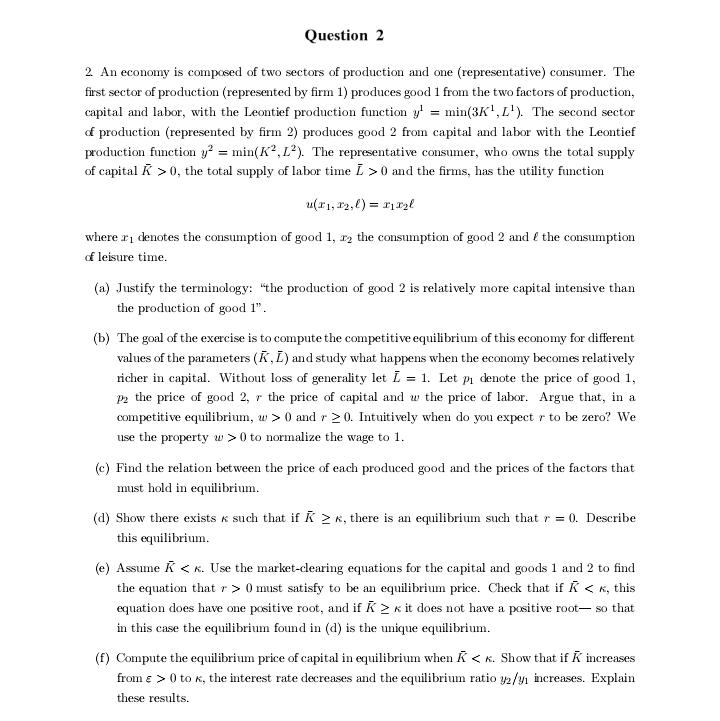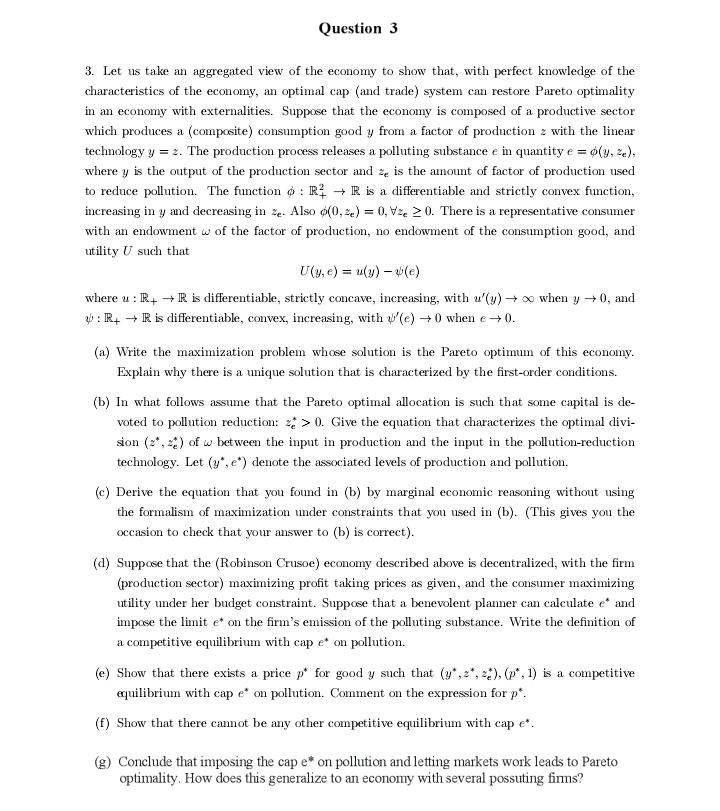



QUESTION 3 You won $200M {$200,000,000} playing the lottery. Two charities have approached you for a donation. You summoned the directors of the two charities and informed them that they will play the following sequential game: First, the director of Charity 1 {call her 0.] will make a public request, which can be any integer dollar amount, starting from iii and up to HWM. Then the director of Charity: {cail him [3,] having heard D. 's request will announce his own request, which, again, can be any integer dollar amount starting 0on1 $I and up to $200M. You infonn them that one of your objectives is to punish greed and thus you will proceed m follows: Let d. denote the amount requested by D. and d, the amount requested by Dz. [f d. rad, then D. being the greedy one will get nothing, while B, will be rewarded with two times what he mked for, up to $200M; that is, .02 will get min{2n'= ,200M} . Synuneoicaily, if d. (d, then Dz will get nothing, while DI will get min{2o'l,200M}. Finally, if if. = d, then each charity will get what it requested, up to $100M, that is, each charity will get min{dl,100M}. {a} Suppose that it common knowledge that each director is selsh and greedy, in the sense that hefshe only cares about how much money hisIher own charity gets, $1111 prefers more money to less. Find all the backward induction solutions. {b} Suppose now that it is common knowledge that each director ranks the outcomes exclusively on the basis of the total amount of money that goes to the two charities {the more the better}. Find ail the backward induction solutions. {c} Now let us change the game. It is no longer a sequential game; instead, each director submits a written request, not knowing how much money the other director is requesting {that is, the game is simultaneous]. Assume that the preferences are as described in part {a}. {cl} Write the payoff functions of the two players. {c.Z] Find all the pure-strategy Hash equilibria. Prove that what you propose are Hash equilibria and that there are no other Nash equilibria. [d] For the simultaneous game of part {c} find all the pure-strategy Hash equilibria when the preferences are as described in part {b}. Prove that what you propose are Nash equilibria 31d that there are no other Nash equilibria. {e} For the simultaneous game of part (c) find all the pine-strategy Mash equilibria when each director has the following lexicographic preferences, that is, outcomes are ranked rst on the basis of the total amount of money that goes to the two charities {the more the better] and then on the basis of how much money hist'her own charity gets {the more the better}. Prove that what you propose are Nash equilibria and that there are no other Hash equilibria. Question 2 2 An economy is composed of two sectors of production and one (representative) consumer. The first sector of production (represented by firm 1) produces good 1 from the two factors of production, capital and labor, with the Leontief production function y' = min(3X], L' ). The second sector of production (represented by firm 2) produces good 2 from capital and labor with the Leontief production function y' = min(K, L'). The representative consumer, who owns the total supply of capital K > 0, the total supply of labor time Z > 0 and the firms, has the utility function u( r1, n,( ) = red where r, denotes the consumption of good 1, ry the consumption of good 2 and / the consumption of leisure time. (a) Justify the terminology: "the production of good 2 is relatively more capital intensive than the production of good 1". (b) The goal of the exercise is to compute the competitive equilibrium of this economy for different values of the parameters ( K, L) and study what happens when the economy becomes relatively richer in capital. Without loss of generality let Z = 1. Let p denote the price of good 1, pa the price of good 2, " the price of capital and w the price of labor. Argue that, in a competitive equilibrium, w > 0 and r 2 0. Intuitively when do you expect r to be zero? We use the property w > 0 to normalize the wage to 1. (c) Find the relation between the price of each produced good and the prices of the factors that must hold in equilibrium. (d) Show there exists & such that if K 2 *, there is an equilibrium such that r = 0. Describe this equilibrium. (e) Assume K > 0 must satisfy to be an equilibrium price. Check that if K 0 to k, the interest rate decreases and the equilibrium ratio 12/y1 increases. Explain these results.Question 2 2 An economy is composed of two sectors of production and one (representative) consumer. The first sector of production (represented by firm 1) produces good 1 from the two factors of production, capital and labor, with the Leontief production function y' = min(3X], L' ). The second sector of production (represented by firm 2) produces good 2 from capital and labor with the Leontief production function y' = min(K, L'). The representative consumer, who owns the total supply of capital K > 0, the total supply of labor time Z > 0 and the firms, has the utility function u( r1, n,( ) = red where r, denotes the consumption of good 1, ry the consumption of good 2 and / the consumption of leisure time. (a) Justify the terminology: "the production of good 2 is relatively more capital intensive than the production of good 1". (b) The goal of the exercise is to compute the competitive equilibrium of this economy for different values of the parameters ( K, L) and study what happens when the economy becomes relatively richer in capital. Without loss of generality let Z = 1. Let p denote the price of good 1, pa the price of good 2, " the price of capital and w the price of labor. Argue that, in a competitive equilibrium, w > 0 and r 2 0. Intuitively when do you expect r to be zero? We use the property w > 0 to normalize the wage to 1. (c) Find the relation between the price of each produced good and the prices of the factors that must hold in equilibrium. (d) Show there exists & such that if K 2 *, there is an equilibrium such that r = 0. Describe this equilibrium. (e) Assume K > 0 must satisfy to be an equilibrium price. Check that if K 0 to k, the interest rate decreases and the equilibrium ratio 12/y1 increases. Explain these results.Question 3 3. Let us take an aggregated view of the economy to show that, with perfect knowledge of the characteristics of the economy, an optimal cap (and trade) system can restore Pareto optimality in an economy with externalities. Suppose that the economy is composed of a productive sector which produces a (composite) consumption good y from a factor of production = with the linear technology y = 2. The production process releases a polluting substance e in quantity e = o(y, 2.), where y is the output of the production sector and z, is the amount of factor of production used to reduce pollution. The function o : R4 - R is a differentiable and strictly convex function, increasing in y and decreasing in ze. Also o(0, 2) = 0, Vz, 2 0. There is a representative consumer with an endowment w of the factor of production, no endowment of the consumption good, and utility U such that U(y, e ) = u(y) -w(e) where u : R. - R is differentiable, strictly concave, increasing, with u'(y) + co when y -+ 0, and 1 : Ry - R is differentiable, convex, increasing, with '(e) - 0 when e - 0. (a) Write the maximization problem whose solution is the Pareto optimum of this economy. Explain why there is a unique solution that is characterized by the first-order conditions. (b) In what follows assume that the Pareto optimal allocation is such that some capital is de- voted to pollution reduction: 2. > 0. Give the equation that characterizes the optimal divi- sion (2*, 2:) of w between the input in production and the input in the pollution-reduction technology. Let (y", e*) denote the associated levels of production and pollution. (c) Derive the equation that you found in (b) by marginal economic reasoning without using the formalism of maximization under constraints that you used in (b). (This gives you the occasion to check that your answer to (b) is correct). (d) Suppose that the (Robinson Crusoe) economy described above is decentralized, with the firm (production sector) maximizing profit taking prices as given, and the consumer maximizing utility under her budget constraint. Suppose that a benevolent planner can calculate e* and impose the limit e* on the firm's emission of the polluting substance. Write the definition of a competitive equilibrium with cap e* on pollution. (e) Show that there exists a price p" for good y such that (y', 2", 2:), (p', 1) is a competitive equilibrium with cap e" on pollution. Comment on the expression for p*. (f) Show that there cannot be any other competitive equilibrium with cap e* (g) Conclude that imposing the cap e* on pollution and letting markets work leads to Pareto optimality. How does this generalize to an economy with several possuting finns?Question 3 3. Let us take an aggregated view of the economy to show that, with perfect knowledge of the characteristics of the economy, an optimal cap (and trade) system can restore Pareto optimality in an economy with externalities. Suppose that the economy is composed of a productive sector which produces a (composite) consumption good y from a factor of production = with the linear technology y = 2. The production process releases a polluting substance e in quantity e = o(y, 2.), where y is the output of the production sector and z, is the amount of factor of production used to reduce pollution. The function o : R4 - R is a differentiable and strictly convex function, increasing in y and decreasing in ze. Also o(0, 2) = 0, Vz, 2 0. There is a representative consumer with an endowment w of the factor of production, no endowment of the consumption good, and utility U such that U(y, e ) = u(y) -w(e) where u : R. - R is differentiable, strictly concave, increasing, with u'(y) + co when y -+ 0, and 1 : Ry - R is differentiable, convex, increasing, with '(e) - 0 when e - 0. (a) Write the maximization problem whose solution is the Pareto optimum of this economy. Explain why there is a unique solution that is characterized by the first-order conditions. (b) In what follows assume that the Pareto optimal allocation is such that some capital is de- voted to pollution reduction: 2. > 0. Give the equation that characterizes the optimal divi- sion (2*, 2:) of w between the input in production and the input in the pollution-reduction technology. Let (y", e*) denote the associated levels of production and pollution. (c) Derive the equation that you found in (b) by marginal economic reasoning without using the formalism of maximization under constraints that you used in (b). (This gives you the occasion to check that your answer to (b) is correct). (d) Suppose that the (Robinson Crusoe) economy described above is decentralized, with the firm (production sector) maximizing profit taking prices as given, and the consumer maximizing utility under her budget constraint. Suppose that a benevolent planner can calculate e* and impose the limit e* on the firm's emission of the polluting substance. Write the definition of a competitive equilibrium with cap e* on pollution. (e) Show that there exists a price p" for good y such that (y', 2", 2:), (p', 1) is a competitive equilibrium with cap e" on pollution. Comment on the expression for p*. (f) Show that there cannot be any other competitive equilibrium with cap e* (g) Conclude that imposing the cap e* on pollution and letting markets work leads to Pareto optimality. How does this generalize to an economy with several possuting finns?QUESTION 4 A new start-up firm, I-Start, wants to hire 50 workers. There are two types of workers that would have the required skills: H and L. A worker of type H would generate a monthly revenue of $ Ry, for the firm and a type 2 worker would generate a monthly revenue of $ R, |for the firm. All workers are currently employed at a monthly salary of $ 5, . We assume throughout that R, 0 per audited worker. Note that no new workers are hired after the m-month probationary period. (d) Write an expression (in terms of the parameters) that gives I-Start's expected total profits over the entire n-month period under Option 2. [Hint: you need to consider two cases. ] From now on assume that R,, =6,000, R, =4,000, S, =4,800, q, =25%, n=36, c = 5,500 and d = 3.000. Thus the only remaining parameters are m, p and k. (e) Assume for this question that & = 0. Rewrite the expressions of part (d) for the values given above and explain the significance of the inequality 2,500m +40.500p-1,125mp














